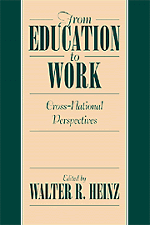Book contents
- Frontmatter
- Contents
- Contributing Authors
- Preface
- Introduction: Transitions to Employment in a Cross-National Perspective
- Part I Social Origin, Gender, and Transition Patterns
- 1 Social and Geographical Mobility 20 Years after High-School
- 2 Diverse Directions: Young Adults' Multiple Transitions
- 3 New Routes to Employment: Integration and Exclusion
- 4 From Education to Employment: Occupations and Careers in the Social Transformation of East Germany
- Part II Education and Labour Markets: Work Experiences, Skills, and Credentials
- Part III Changes in the Social Context of Transitions
- References
- Index
4 - From Education to Employment: Occupations and Careers in the Social Transformation of East Germany
Published online by Cambridge University Press: 30 September 2009
- Frontmatter
- Contents
- Contributing Authors
- Preface
- Introduction: Transitions to Employment in a Cross-National Perspective
- Part I Social Origin, Gender, and Transition Patterns
- 1 Social and Geographical Mobility 20 Years after High-School
- 2 Diverse Directions: Young Adults' Multiple Transitions
- 3 New Routes to Employment: Integration and Exclusion
- 4 From Education to Employment: Occupations and Careers in the Social Transformation of East Germany
- Part II Education and Labour Markets: Work Experiences, Skills, and Credentials
- Part III Changes in the Social Context of Transitions
- References
- Index
Summary
…for a sociologist nothing else is as fascinating as the collapse of a society
(Ganβmann, 1993; p 172).Hardly ever in history has a process of rapid and radical social change been as much the object of continual observation and analysis by the social sciences as the modernization and transformation process of the former Soviet bloc. Numerous large- and small-scale projects have been launched to investigate this secular historical event in various countries. With respect to the destiny of Europe, historians like to compare the breakdown of the Soviet bloc with the French revolution of 1789 and the Russian revolution of 1917, both of which split the continent; the revolution of 1989 tore down the dividing lines of confrontation, however. In the case of the German Democratic Republic (GDR), a parallel is drawn between 1989 and the German bourgois revolution of 1848 (Kocka, 1995). After 1989, Germany reassumed her uncomfortable position in the center of the continent.
In terms of sociological theory, the collapse of the Soviet bloc and the subsequent dramatic social change in a number of countries is seen by scholars from different schools as an instructive example of postponed modernization, a rectifying revolution of an erroneous pathway (Collins & Waller, 1993; Habermas, 1990a, 1990b; Joas & Kohli, 1993; Zapf, 1996). Since the end of Soviet hegemony over central and eastern Europe, civil societies of the Western type have been restored or established for the first time.
- Type
- Chapter
- Information
- From Education to WorkCross National Perspectives, pp. 87 - 108Publisher: Cambridge University PressPrint publication year: 1999
- 4
- Cited by



